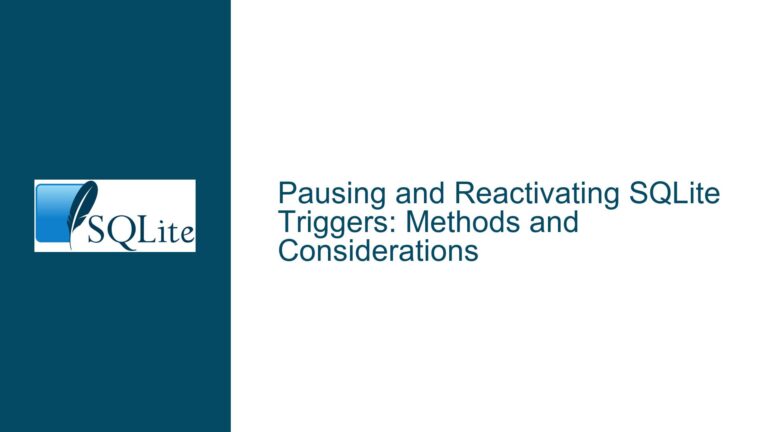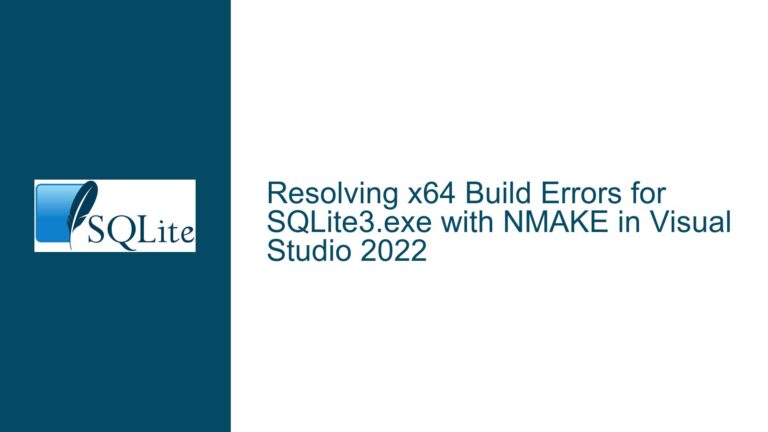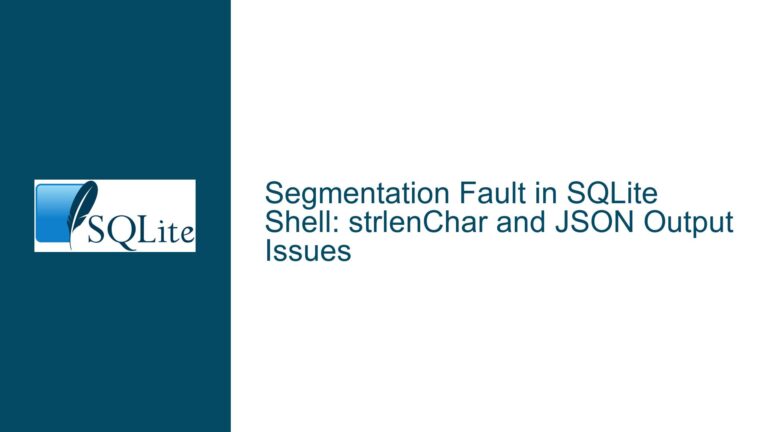sqlite3_txn_state Behavior After ROLLBACK in SQLite
Issue Overview: sqlite3_txn_state Returns 1 After ROLLBACK
When working with SQLite in WAL (Write-Ahead Logging) mode, developers often encounter nuanced behaviors related to transaction states, particularly when using the sqlite3_txn_state API. A common issue arises when sqlite3_txn_state returns a value of 1 (indicating an open read transaction) after a ROLLBACK operation, even though the expectation is that it should return 0 (indicating no active transaction). This behavior can be confusing, especially when the transaction was initiated with BEGIN IMMEDIATE, which is typically associated with write transactions.
The core of the issue lies in the interaction between explicit write transactions (BEGIN IMMEDIATE), implicit read transactions (initiated by SELECT statements), and the state management of these transactions. Specifically, the problem occurs when a SELECT statement is executed within a write transaction but is not fully completed (i.e., not stepped to SQLITE_DONE or reset). In such cases, the read transaction remains open even after the write transaction is rolled back, leading to the observed sqlite3_txn_state value of 1.
This issue is not a bug in SQLite but rather a result of the database’s transaction management model, which distinguishes between write and read transactions and handles them independently. Understanding this behavior requires a deep dive into SQLite’s transaction states, the implications of BEGIN IMMEDIATE, and the lifecycle of prepared statements.
Possible Causes: Incomplete SELECT Statements and Transaction State Management
The primary cause of the observed behavior is the incomplete execution of a SELECT statement within a write transaction. When a SELECT statement is prepared and stepped but not finalized or reset, it leaves an implicit read transaction open. This read transaction is independent of the explicit write transaction initiated by BEGIN IMMEDIATE. As a result, even after a ROLLBACK or COMMIT operation on the write transaction, the read transaction remains active, causing sqlite3_txn_state to return 1.
Another contributing factor is the distinction between explicit and implicit transactions in SQLite. Explicit transactions are those initiated by BEGIN, BEGIN IMMEDIATE, or BEGIN EXCLUSIVE, while implicit transactions are automatically started by certain operations, such as SELECT statements. SQLite manages these transactions separately, and their states are not always synchronized. For example, a ROLLBACK operation only affects the explicit write transaction and does not automatically close any associated read transactions.
Additionally, the behavior of sqlite3_txn_state can vary depending on the journaling mode (e.g., WAL vs. DELETE) and the specific SQLite version being used. In WAL mode, read and write transactions can coexist more seamlessly, which can sometimes obscure the underlying transaction states. However, the fundamental principles of transaction management remain consistent across modes.
Finally, the issue can be exacerbated by incorrect assumptions about the lifecycle of prepared statements. Developers may assume that a SELECT statement is automatically finalized when the transaction is rolled back, but this is not the case. The statement must be explicitly reset or finalized to close the associated read transaction.
Troubleshooting Steps, Solutions & Fixes: Ensuring Proper Transaction and Statement Lifecycle Management
To resolve the issue of sqlite3_txn_state returning 1 after a ROLLBACK, developers must ensure proper management of both transactions and prepared statements. Below are detailed steps and solutions to address the problem:
1. Complete the Execution of SELECT Statements
The most critical step is to ensure that all SELECT statements are fully executed before finalizing the transaction. This means stepping the statement until SQLITE_DONE is returned or explicitly resetting the statement using sqlite3_reset. Failure to do so leaves the read transaction open, which can lead to unexpected sqlite3_txn_state values.
For example, if a SELECT statement returns SQLITE_ROW, the developer must continue stepping the statement until SQLITE_DONE is returned. Alternatively, the statement can be reset immediately after processing the required rows. This ensures that the read transaction is properly closed.
2. Explicitly Finalize or Reset Prepared Statements
After executing a SELECT statement, developers should explicitly finalize or reset the statement to release any associated resources and close the read transaction. This can be done using sqlite3_finalize or sqlite3_reset. Finalizing the statement is particularly important when the statement is no longer needed, as it frees up memory and ensures that no lingering transactions remain open.
For example:
sqlite3_stmt *stmt;
int rc = sqlite3_prepare_v2(db, "SELECT data FROM cache WHERE id=?", -1, &stmt, NULL);
if (rc == SQLITE_OK) {
while ((rc = sqlite3_step(stmt)) == SQLITE_ROW) {
// Process the row
}
if (rc == SQLITE_DONE) {
// Statement completed successfully
}
sqlite3_reset(stmt); // Reset the statement to close the read transaction
}
sqlite3_finalize(stmt); // Finalize the statement to release resources
3. Understand the Implications of BEGIN IMMEDIATE
Developers should be aware that BEGIN IMMEDIATE initiates an explicit write transaction but does not automatically close any existing read transactions. This means that a SELECT statement executed within a BEGIN IMMEDIATE transaction can still leave a read transaction open, even after the write transaction is rolled back or committed.
To avoid confusion, developers should ensure that all read transactions are properly closed before initiating a write transaction. This can be done by finalizing or resetting any active SELECT statements.
4. Monitor Transaction States Using sqlite3_txn_state
The sqlite3_txn_state API can be used to monitor the state of transactions on a connection. However, developers must interpret the results correctly. A return value of 1 indicates an open read transaction, while a value of 2 indicates an open write transaction. A value of 0 indicates no active transaction.
By monitoring sqlite3_txn_state at key points in the code, developers can identify and address any lingering read transactions. For example:
int txn_state = sqlite3_txn_state(db, "main");
if (txn_state == 1) {
// An open read transaction exists
// Reset or finalize any active SELECT statements
}
5. Use Proper Error Handling and Debugging Techniques
Developers should implement robust error handling and debugging techniques to identify and resolve transaction-related issues. This includes checking the return codes of SQLite API calls and logging relevant information, such as the state of transactions and prepared statements.
For example:
int rc = sqlite3_step(stmt);
if (rc != SQLITE_DONE && rc != SQLITE_ROW) {
// Handle the error
fprintf(stderr, "SQLite error: %s\n", sqlite3_errmsg(db));
}
6. Consult SQLite Documentation and Resources
Finally, developers should consult the official SQLite documentation and resources to gain a deeper understanding of transaction management and the behavior of sqlite3_txn_state. The documentation provides detailed explanations of transaction states, the implications of different journaling modes, and the lifecycle of prepared statements.
For example, the section on transaction control in the SQLite documentation (https://sqlite.org/lang_transaction.html) provides valuable insights into the behavior of BEGIN IMMEDIATE, COMMIT, and ROLLBACK operations.
By following these troubleshooting steps and solutions, developers can effectively manage transaction states in SQLite and avoid the issue of sqlite3_txn_state returning 1 after a ROLLBACK. Properly handling the lifecycle of prepared statements and understanding the nuances of transaction management are key to ensuring robust and reliable database operations.






